Our Collective Voice: How the Duke Rape Hoax Became the Duke Racial Epithets Crime-of-the-Century Hoax (and Remains So Today)
By Momtothree
Yes, the racial epithets. We’ve heard so much about them. They’re always included in the story. - sometimes introduced by words such as “hurled”,” barked” or “screamed.” Most mainstream media commentators take it as a given that such things were said, even if they are not sure what things were said – except for the “thank your grandpa for my cotton shirt” comment reported by Jason Bissey. The epithets, whatever they are considered to be, have a prominent place in and give the only real weight to the litany of offenses – underage drinking, peeing in the bushes, hiring strippers, and giving a slightly modified version of your last name to an escort agency – that are cited to make sure everyone understands that the Duke lacrosse players were “no angels.”
When looked at more closely, it is really the allegation that racial epithets were used by the players that gives the case its racial charge. Even the purple prose assertion about elite whites having their way with poor black women seems to need the force of abusive language to get the scene fully set. The differing race of accused and accuser doesn’t seem to be sufficient by itself to make the alleged crime racial.
Let it be said up front that racial epithets are deeply reprehensible, and concede that probably one or more of the party attendees did utter something racial. That the AG has concluded this occurred as a response to racial taunting from Kim Roberts gives context, but not justification for these words. Yet what has been made of them, and the way these utterances have been used to condemn an entire team and smear the reputations of the three indicted players (whom no one has ever seriously claimed uttered any epithet) is far more disgraceful and blameworthy.
Ironically, the first news stories about the alleged incident contained no mention of anything racial and did not identify the race of the accuser or of the “three males” she claimed had attacked her. The first inkling the public has of the case is the email message which Sgt. Gottlieb sent to the Trinity Park listserv on the morning of March 17:
Date: Fri, 17 Mar 2006 10:15:46 -0500
The Durham Police District 2 Criminal Investigations Violent Crimes Unit is conducting an investigation concerning a rape of a young woman by three males at 610 N. Buchanan that was reported on 3/14/06 in the early morning hours. The female arrived at the residence for a party close to 11:30pm on Monday 3/13/2006 and left on Tuesday 3/14/2006 reportedly after midnight. Anyone in the area who saw or heard anything unusual, please contact Investigator Himan at 919-560-4582 x 229 or I at 560-4582 x 228. Thank you for your continued assistance.
Sgt. M.D. Gottlieb
Durham Police District 2 Investigations
919-560-4582 x 228
Initial Media Reports
The first news story on the case appeared in the N&O on March 18. It was very brief:
March 18, 2006
Column: Triangle BriefsWoman Reports Sexual Assault
From Staff ReportsPolice were investigating a report of a rape on Buchanan Boulevard near the Duke University campus Friday.
A young woman told police she visited 610 N. Buchanan Blvd. about 11:30 p.m. Monday and was assaulted by three men, according to police Sgt. Mark Gottlieb.
Anyone with information is asked to call Investigator B.W. Himan at 560-4582, ext. 229
A slightly longer story appeared the next day:
March 19, 2006
Alleged rape was at party, police said
From Staff ReportsPolice offered more details Saturday in the investigation of a young woman's report she was raped by three men at a party Monday near the Duke University campus.
The woman told police early Tuesday morning that she had gone to a house at 610 N. Buchanan Blvd. about 11:30 p.m. the night before for a party, said Sgt. Mark Gottlieb.
While at the party, she was raped by three men, she reported to police.
Gottlieb described the party as a mix of college students and nonstudents. In total, there were about 30 people there at the time, he said.
"It was an act where alcohol was involved," Gottlieb said.
It is The News & Observer's policy not to identify victims of reported sexual crimes.
The only new information that the March 19 article provided is that the alleged incident occurred at a party attended by a mix of students and non-students. The quote from Gottlieb that “it was an act where alcohol was involved,” suggests, as in his listserv email, that the “act” is factual.
The Herald Sun also ran a small news item on the incident on March 18. It did not identify race and differed from the N&O stories only in directing those with information to call either Officer Himan or Crimestoppers, giving numbers for each.
The first news story in the Duke Chronicle was published on March 20. It is also brief, but at least uses the word ‘alleged’ in referring to the crime. Some background information is given on the 610 location, including the fact that Duke had recently purchased this house as well as other houses in the neighborhood. It also describes Gottlieb’s email to the neighborhood asking for information.
The Duke Chronicle
March 20, 2006
Off-East house site of reported rape
By: Staff Reports
Issue date: 3/20/06 Section: News
Durham Police Department is investigating an alleged rape of a young woman by three males at 610 N. Buchanan Blvd. over Spring Break.
Duke recently purchased the rented residence from a local landlord.
The alleged assault was reported early in the morning of Tuesday, March 14.
The young woman arrived at the house for a party at around 11:30 p.m. Monday, March 13 and reportedly left after midnight, Sgt. M.D. Gottlieb of Durham Police District 2 Investigations wrote in an e-mail to a community listserv.
He encouraged individuals in the area at the time to report to DPD if they "saw or heard anything unusual."
Gottlieb could not be reached for comment.The house at 610 N. Buchanan is one of 12 in the Trinity Park neighborhood that Duke purchased from Trinity Properties, a local real estate firm, in early March.
The University bought, in total, 15 properties near East Campus for approximately $3.7 million.
The purchased homes are mostly student-occupied, and many are the frequent subjects of noise, trash and partying complaints filed by Trinity Park residents.
Duke plans to turn the houses into single-occupancy residences.
It seems fairly obvious that Gottlieb was the source, directly or indirectly, for each of these stories. The fact that they contain no racial identification suggests that Gottlieb made some kind of conscious decision not to introduce race into the story at this point. Why exactly he chose to avoid that aspect in this time frame is not clear, but, the effect certainly was to keep the story low key in these early days with minimal impact on either Duke or the public at large.
The story then disappears from the news cycle until early March 24, when the N&O reports on the DNA testing of 46 of the 47 lacrosse players at the Police crime lab in downtown Durham. Mark Gottlieb is described in the article as being on the scene, and he was almost certainly the person who alerted the N&O reporters that the testing was going to take place.
The March 24 article also contains a description of the crime, the first description to be made public. The description appears based on the March 16 search warrant language rather than the considerably more violent depiction of the crime in the false probable cause affidavit in the Non Testimonial Identification Order (NTO) issued on March 23. That version includes the broomstick comment, (quoted falsely as “I’m going to shove this up you”) and the fraudulent claim that the false accuser's nails broke off as she clawed at her "attacker" and struggled to breathe. The article describes the attack this way, under the emboldened heading: “Heated Atmosphere.”
According to the warrant, the victim told police she went to the home late March 13 with another woman to dance for a group of men. She and the other female dancer started to perform in the master bedroom of the house, and soon, the men who were watching became "excited and aggressive," the statement says.
The women stopped dancing and wanted to leave, concerned for their safety. They went outside and got into a car and were approached by one of the suspects, who apologized and asked that the women come back inside, the warrant says.
The women went back inside the house and were separated. The victim was pulled into a bathroom, and three men held her down, sexually assaulting and sodomizing her, the warrant says. She was kicked, hit, strangled and beaten, she told police.
The victim went to the Kroger grocery store on Hillsborough Road and called police at 1:22 a.m. March 14, the warrant says.
Besides being unknown to the public, and unreported by the press, during this time period, the race of the accuser was also allegedly not a fact known to anyone in Duke administration in these first days, (with the exception of the officers of the Duke University Police Department who had been involved in initially responding to and investigating the incident). That the administration, including President Brodhead, lacked such knowledge was later identified by the Bowen-Chambers investigative committee and report as, in fact, a “major failing” [p.2] and was one of the factors, along with hearing from the Duke police that the accuser was not credible and had changed her story, that led top administrators to “seriously underestimat[e] the seriousness of the allegations.” [p.4]
The Report recounts in detail how the Duke Police Department communicated the known facts of the incident to Dean Sue Wasiolek on the morning of March 14, but inexplicably failed to include in that communication the fact that the woman alleging rape was black. As a result, the persons with whom Dean Sue soon communicated, Coach Pressler, Director Alleva, and Larry Moneta, and eventually Tallman Trask and Richard Brodhead, all also lacked this information as they worked to devise the institution’s response. They did not learn about “the racial aspects of the situation”, according to the Report, until March 24. [p.2] The Report calls this gap in communications “extraordinary.” [p.3]
Interestingly enough, the Report does not say how President Brodhead, or any of the other key administrators, did, in fact, learn about the “racial aspects,” only that they did so on March 24. The Report notes that Brodhead first learned of the case from the article in the Duke Chronicle of March 20, and that he learned of the DNA testing on March 23 from John Burness who was receiving calls from the media. On March 25th, he learned from the N&O profile that the accuser was a student at NCCU [p.3], but the Report gives no specifics as to what he and Dean Sue and Larry Moneta learned on March 24 and from what source they learned it.
Hence, at the end of the day on Thursday, March 23 and going into March 24, we have two of the major players in the Duke Hoax drama - the media and the Duke administration – both beginning to see that this is potentially a significant and developing case but as yet having no inkling of its racial aspects. That will suddenly change.
The N&O Starts the Race Hoax
On March 24, a reporter for the N&O, Samiha Khanna, will interview Crystal Mangum, and the N&O will publish an article based on the interview on March 25. From this article, the rest of the media and the general public will quickly learn that both the alleged victim and the other exotic dancer who performed with her at the party are black. But far more critical to the development of a frenzied atmosphere around the discussion of this alleged crime, the interview will put front and center the charge that the players spewed racially abusive language at the two dancers.
The publication of the N&O interview article has long been seen as pivotal moment in the case. But the actual content of this article is sometimes conflated with the subsequent article about the accuser published by the N&O on April 16. It was the latter piece that worked so hard to ‘humanize’ the alleged victim, depicting the accuser as a “petit, softspoken woman, and describing her as “a caring mother and a hard worker” who “recently received an A in a difficult course." The March 25 article provided only a few details about the accuser. It said she had two children, was a full-time student at NCCU, and that she “had worked for an escort company for two months, doing one-on-one dates about three times a week.” It also made the claim, eventually shown to be ridiculously false, that “[t]his was the first time she had been hired to dance provocatively for a group.”
However, the real focus of the initial article was less the accuser than the rowdy and racially defamatory behavior of the accused lacrosse players, and this was the fundamental impact that the article had on the public’s perception of the case.
Samiha Khanna’s interview with Crystal Mangum
Khanna herself gave a number of interviews in which she described some of the circumstances of her interview with Mangum. In describing Mangum, as she had encountered her, Khanna consistently pictured Mangum as tearful, stressed, and not forthcoming. On March 29, in the course of an interview on MSNBC, Dan Abrams asked Khanna: “What did she say happened exactly?” Khanna responded:
“Basically, we just sort of went over the same details that the police had offered. She was a little hesitant to discuss everything in detail. Naturally, she was still in shock and still very tearful, and also her children were present.” MSNBC
On March 31, in an interview with Laxcast, Khanna painted an even more emotional picture of Mangum as stressed, crying and untalkative. The Laxcast interviewer asked Khanna if she found the accuser to be credible. Khanna responded:
I can’t really make a judgment one way or another, but I do know, I can tell you what I did see. And that is that she was visibly upset when we spoke. She seemed to be in physical pain. It was difficult for her to speak about it and she didn’t actually share a lot of the information with me.2 She seemed hesitant. And she was emotional. Whether she’s credible or not, I can’t really be a judge of that, but I can tell you that, just based on my interaction with her, she did express and seem to be stressed, maybe traumatized. [Emphasis added] Laxcast
It is not easy to square this depiction of Mangum, weeping and not eager to talk, with what must be another portion of the interview in which Mangum recounts to Khanna details of her life - working for the escort agency, being a full time student at NCCU, juggling her schedule, pointing out that this was the first time she had danced provocatively for a group, and then describing the arrival of the two dancers at 610 Buchanan and their experiencing a barrage of racial slurs moments after they arrive. It is also hard to square Khanna’s contention that Mangum “seemed to be in physical pain” with Khanna’s later recollection in her April 16, 2006 article that Mangum had a gym bag over her shoulder when Khanna first met her.
Other aspects of the N&O interview with Mangum also raise questions. At various times, Khanna and her editor, Linda Williams, have given different impressions and even conflicting accounts of the length of the interview and how it took place. Khanna, in her early discussions of the interview and her references to it in the April 16, 2006 article, suggests that it was short, but still quoted quite a number of individual things that the accuser supposedly said during the interview
Later, Linda Williams, in a comment on the N&O Editors’ Blog on October 5, 2006, described it as a brief encounter of a few minutes that took place outside Mangum’s parents’ home:
There is a mistaken assumption that the N&O conducted an extensive interview with the woman and deliberately withheld a substantial portion of the interview.
Those assumptions are false. The reporter’s interview with the woman was brief, an encounter that lasted a few minutes outside the woman’s parents’ home in Durham. [Emphasis added]
An interview of a few minutes, outside a house, with at least one child present (if the further description from Khanna’s April 16 article is correct), with the subject of the interview tearful, stressed and not willing to talk, seems an unlikely situation in which a person would give an account of the events leading up to a sexual assault, including a description of racial slurs, while also discussing, at some point, the interviewee’s life as a mother, student and escort worker (doing one on one dates several times a week). It might have so happened, but it seems unlikely.
Unlikely enough that Khanna took pains a full six months later, in an article published on April 12, 2007, the day after the remaining charges against the lacrosse players were dismissed, to correct the record regarding her interview of Mangum a year before. In her April 12 article, Khanna presents a new and rather different version of the interview – describing it now as occurring in two parts:
The interview began in front of Mangum's parents' home near N.C. Central. When an N&O reporter approached, she confirmed that she had made the rape report. She started crying.
When asked why she made the report, she said, "Most guys don't think it's a big deal" to force a woman to have sex. She confirmed that the claimed incident occurred at a party near Duke.
Moments later, she added, "Maybe they think they can get away with it because they have more money than me."
After a few moments, Mangum said she had to leave, but she consented to meet that afternoon.
Later, she sat in her living room for less than 15 minutes to answer more questions. [Emphasis added]
While this version logically makes more sense and appears more truthful than Williams' “few minutes” in front of the house, it also raises some questions.
If Khanna first caught up with Mangum coming out of her parents’ house and then made an appointment to meet “that afternoon,” the obvious implication is that Khanna first meets Mangum in the morning. But if Khanna’s statement in the April 16, 2006 article that Mangum’s son was present is true, than the encounter must have been quite early in the morning, before the child set off for or was taken to school (the interview date, Friday March 24, would have been a school day in Durham; spring break was the next week). But none of the references to Mangum’s daily life during March 2006 which occur in the record of the case (cf, Jarriel Johnson’s statement, the interview with Brian Taylor, or Himan’s notes of how Mangum claimed to have spent the day of the lacrosse party), suggest that she was ever up early enough in the morning to enable a reporter to encounter her on her porch at say 8:00 or 8:30 in the morning.
That the N&O’s continued dissembling about the interview over more than a year suggests there remain aspects about the interview that the N&O would still rather not reveal.
One question that arises out of the comments made by Linda Williams is whether any agreement was made between the N&O and the police as a condition of the N&O being allowed to conduct the interview.
Williams has made clear on at least two occasions that the decision to publish only material that conformed with the police reports was made prior to the interview being conducted.
In a column published in the N&O on April 2, 2006, Ted Vaden, the N&O Public Editor, attributed the following discussion of the background of the interview to Williams:
Williams said editors and the reporter discussed the fairness issue at length before interviewing the woman and publishing the story. The governing decision, she said, was to print only information from the interview that conformed with the police reports. "We limited for publication the statements from the woman that were in line with what she said in the police report," Williams said. Other information from the interview has not been published. [Emphasis added]
In her October 5 blog comment, Williams says:
“The decision made prior to the March interview to limit it to the information in the police report was the correct decision and I stand by it. Our purpose was to hear from the woman in her own words the accusation she made to the police. We also wanted to know if she would say anything that contradict [sic] the police report. In the brief interview, she repeated the information we knew to be the gist of the police report that we had access to at that time.” [Emphasis added]If the decision was made prior to the interview, it was made prior to the reporter or the editors having any idea what Mangum would say. Why then did they anticipate that Mangum would say anything that was essentially different from what was in the police report that caused this lengthy discussion to take place? The prior news stories had not indicated that Mangum might not be a credible witness. Moreover, if prior to the interview, the editors had already made the decision “to limit it to the information in the police report,” what exactly did they expect to be the new information that they would publish – that would be the justification for having this story at all? For the reporter and the editors to have engaged in this discussion is so odd as to be simply incredible.
A far more reasonable assumption is that the constraint was imposed on the N&O by the Durham police, whom all logic suggests were the ones who were facilitating, if not indeed instigating, the interview with the accuser.
There was certainly a risk for the police in putting a reporter in touch with Mangum. The police already knew that Mangum had changed her story a number of times. In permitting an interview of Mangum, there was certainly a chance that a new story, or at least details that contradicted a prior story, would emerge. If the police were interested in pushing the case forward, as their implementation of a measure as dramatic as the NTO suggests they were, they would have needed some kind of assurance that material detrimental to the case would not be published.
Khanna’s various descriptions of her interview with Mangum, especially her most recent discussion of the interview in the April 12 article – gives some indication that the constraint may actually have limited what the reporter would even have been allowed to ask Mangum, rather than just what the paper was allowed to publish.
For example, Khanna told Dan Abrams on March 29, 2006: “Basically we just sort of went over the same details that the police had offered. She was a little hesitant to discuss everything in detail.” – Khanna’s words suggest that she initiated some kind of discussion of the rape story as told in the police report, but that Mangum provided little or no detail about the event. By April 12, 2007, however, Khanna’s words suggest that the assault itself was not in fact discussed in the interview – only that Mangum asserted to her that it happened. After describing the women going back into the house and then being separated, Khanna writes: “She did not give details but maintained that she had been raped.” [Emphasis added]
Notice Khanna does not say, “She refused to give details (or did not want to give details) when I asked her about the rape.” There is no indication that Khanna attempted to probe for details or to follow up in any way. It is hard to imagine a reporter asking not even one question about the horrific allegations that had led the reporter, Khanna, to be interviewing Mangum in the first place. As it was, the only detail that Mangum apparently volunteered was her statement that she believed the second dancer had also been assaulted, but did not want to report it for fear of losing her job with the escort agency. The N&O felt obliged to withhold that comment.
The conclusion seems inescapable that Khanna was in no way conducting a normal interview and that her questioning or lack of questioning was limited by some kind of prior understanding.
Some involvement of Khanna with the Durham police in the March 24 interview seems obvious. How far this involvement went can only be surmised. In an interview that Khanna gave to Laxcast on March 24, Khanna indicated that she had previously “sat down with” the Sergeant [Gottlieb] five days after the incident and later “pressed the police a little bit more to find out what exactly happened.” Khanna was clearly probing with the police and, from what she says, was personally known to and had at least one meeting with lead investigator, Gottlieb. We can’t know at this point, but can certainly wonder what other contacts they had.
While many questions remain about the background of the N&O interview article and about the sourcing of its various elements, the intent of the article and its impact on the public and on the perception of the case is not in doubt. The N&O article introduced race to the case, and even more crucially, made racial motivations and racial abuse central to the story.
In the March 25 interview, the N&O actually makes the hurled racial slurs the most prominent feature of the story. The contention that the players “barked” racial slurs at the dancers appears in the second paragraph, and is followed by a quote from the accuser – “We started to cry. We were so scared.” - that will be repeated endlessly by other media. The second paragraph also notes specifically, in case any reader has not caught on, that both women are black. The alleged assault itself is not mentioned until many paragraphs later. It is impossible not to conclude, base on the charged content of the racial material and its positioning in the N&O article, that the purpose of the article is to put the racial aspect up front in the case and to present the alleged crime as, fundamentally, racial in nature.
From what we know at this point about the record of Mangum’s prior statements, the story told in the N&O article of the players shouting racial slurs as the dancers start to perform is actually a new story told by Mangum for the first time on March 24. Mangum’s earlier stories, to the extent we know them in any detail, do not have events occurring this way.3 In several of her early statements (as reported by Nurse Levicy, by Officer Himan in his typed summary of his notes, and in Gottlieb’s undated Supplemental Case Notes, Mangum is said to have claimed that racial taunts were directed at her, but in each case, she describes the slurs as occurring during the alleged assault and not before.
Even so, what Khanna later says Mangum told her that day is again slightly different from the version of the story that Khanna puts in her article. The story in the published article places the racial slurs as occurring “just moments after [the dancers] started to perform.” Yet Khanna, in her subsequent comments about the interview, indicates that Mangum told her that the racial commentary started as soon as the dancers entered the house. In her March 29 interview with Dan Abrams, Khanna says:
When she arrived with one more person from the agency she realized that the crowd, in fact, was over 40 men in this house next to east campus. She worried about the fact that there was no security, and a neighbor that I interviewed actually says that he saw the women outside. The victim was hesitant. She didn’t want to go inside. She said I had never done this before and the other woman he describes sort of comforted her. She went in and she says that immediately there were comments being made, derogatory comments to her as a woman and also based on the fact that of her race. She is black and she says that her accusers are white. [Emphasis added]
The same day Khanna tells a CNN interviewer a similar version of the racist remarks:
So she goes in, and apparently they start yelling racial slurs at her. Really nasty ones. And at one point she leaves the party but then she goes back in. [Emphasis added]
When Khanna retells the story of the interview a year later, the contention is still there that the racist remarks were made as soon as the dancers entered the house:
Mangum said that as soon as she and the second dancer entered the house, they were barraged with racist remarks. [Emphasis added]
Thus, the more consistent version of what Khanna says Mangum told her on March 24 is that the alleged racial commentary starts as soon as the dancers enter. Khanna does not specify the actual content of the remarks, but says that they were “really nasty.” and ‘derogatory to her as a woman and also based on the fact of her race.”4
Two similar stories
While Mangum’s story told to Khanna on March 24 of racial slurs shouted as the dancers enter the house is, as far as we can tell, a new story not previously appearing in Mangum’s earlier statements – it is quite surprising that a rather similar story of a racial slur shouted up front at the dancers makes its way, in an almost comical instance of the game ‘telephone’ - but no doubt with serious intent – from the Durham police to the Duke police to a Duke administrator and to Duke faculty, very likely on the same day as the Khanna interview, March 24.
Other than the similarity of the stories, there is no obvious link between the two events – Khanna’s interview of Mangum and the telephone call received by John Burness. Yet one clear tie – besides the date – is that both events are important elements in the transformation of the Duke Hoax into a racial case, and to go further, seem intended to have that result.
The Holloway/Burness email exchange
This section will focus on an email exchange between John Burness, and Karla Holloway, a Professor of English at Duke that occurred early in January, 2007 and that describes a phone call from the Duke police to Burness, the content of which Holloway claims (and Burness confirms) was either overheard by Holloway or repeated to her by Burness.
Parts of this email exchange, including the allegation that the phone call from the Duke police described lacrosse players using a particular racial epithet when the dancers arrived, were made public in an article published in January by Wilmington Journal columnist, Cash Michaels. The full content of the emails was later posted by Cash Michaels on lacrosse case message boards.5 The email from Holloway also refers to, and gives some descriptive information about, a faculty meeting that apparently took place at the same time as Burness received the call from the Duke police. Holloway’s comments in the email indicate that the faculty meeting was a meeting with Duke Provost, Peter Lange, and that members of the faculty during this meeting were “arguing with him whether it was one racial epithet or more, and how that did or did not matter.”
Before going into more particulars of the emails, let’s consider the evidence that the events described in Holloway’s email took place on March 24.
Burness, in his email to Cash, which Cash also made public, corrects Cash’s idea (which we have to assume Cash gleaned from his original source) that the phone conversation with the Duke police occurred “before the incident of 13 March became public.” Burness says he believes “the conversation described in these emails occurred some 10 days to two weeks later.” That would place the call and the faculty meeting in the time frame of March 23 through March 28. [Though Burness gives the impression that he is uncertain about the date, he admitted to having kept notes, and it is hard to believe he doesn’t know, or couldn’t easily reconstruct, the actual date.]
However, if the suggestion conveyed to Cash Michaels has truth behind it, that something was not public at the time of the Duke police’s call to Burness, what was not public on March 24, but was public beginning on March 25, were the “racial aspects’ of the case – the fact that the accuser was black and the allegation that racial comments were made to her and the other woman. Furthermore, in the meeting, Holloway says that the faculty was arguing about whether “it was one racial epithet or more.” This only makes sense on March 24, since Mangum’s allegation, which will be made public the next day in the N&O article, is clearly that multiple racial comments were made, including the ‘cotton shirt’ comment reported by Bissey. Lastly, Khanna, in the March 25 article, quotes Paul Haagen, chair of Duke’s Academic Council. The article says that Haagen “was in a faculty meeting about the incident,” implying that he was in a meeting the same day that he spoke to the reporter. Nothing suggests that the date of this interview with Haagen was other than the day prior to publication, March 24.
Combining these assumptions with the information in Bowen-Chambers, we can, with good support, conclude that all of the following happened on March 24:
- Key Duke administrators, including President Brodhead, learned of the racial aspects of the case. (Bowen-Chambers)
- Some number of faculty members also learned of the race elements of the case on that day, either separately or from the same source as the administrators.
- There was a faculty meeting at which these aspects were discussed. (Holloway email supported by Haagen interview)
- Lastly, if, as Holloway later contends in her email, the call from the Duke police to John Burness came during the faculty meeting, then the call, too, must have occurred on March 24.
In January 3, 2007, President Brodhead made the decision to offer Reade Seligmann and Collin Finnerty reinstatement to Duke. The decision prompted, Karla Holloway, an Enlish Professor who is also an African-American, to resign from the Campus Cultural Initiative, a committee created in April 2006 by Brodhead to conduct a “self-examination” of Duke’s campus culture, and for which Holloway chaired the subcommittee on race. In her letter of resignation, as quoted in the Duke Chronicle, Holloway describes “the decision by the university to readmit the students, especially just before a critical judicial decision on the case, [as] a clear use of corporate power, and a breach, I think, of ethical citizenship,” She went on to say that she could “no longer work in good faith with this breach of common trust,” and claimed that by reinstating the students, Duke was taking on the role of judge and subverting the process.
In an email to some of her colleagues the same day - the email is addressed to “blkfaccaucus” – presumably black faculty caucus (Did we know there was such a thing?) - Holloway spoke more directly about her gripe with the administration. To her, the main issue was that that the university had not undertaken an investigative and judicial process of its own with respect to the accused students. She wrote:
There has been no process, no hearing no assignment to campus judicial policies for these students. Just blanket readmission and welcome.
Moreover, her unhappiness about this matter appears to be of long-standing, going back to the initial days of the Hoax when she first learned that race was a factor in the alleged incident. Holloway tells her colleagues that she is about to share with them something “which has colored this matter for me since last spring,” and “speaks volumes” about why she thinks Duke needs to hold a “legal hearing.” She writes:
Last spring, while sitting in VP Burness' office, at the moment faculty were meeting with the provost arguing with him whether it was one racial epithet or more, and how that did or did not matter (some of you recall this meeting, I am sure...), the Vice President took a call from the Duke Police, who had returned from a meeting with the Durham Police. He repeated aloud what the person on the phone was telling him: "So you are telling me that when the boys opened the door and saw the dancers they said "Oh no, we're not going to f--k a "n" bitch." [Emphasis added]She concludes by asking “what does it mean to readmit students with an indictment for violent acts without an internal investigation of our own regarding the event?” Holloway’s grievance seems to be less that the students were readmitted while still under indictment (she even refers earlier on to “our judgments about the prosecutor’s lack of principled conduct), but that “the event” was not the subject of an internal investigation and judiciary hearing by Duke.
By sharing with her colleagues this story of the overheard phone call and the accusation reported in it, Holloway makes clear that the aspects of the case that deserve “an internal investigation” and “legal hearing” from Duke are racial aspects, especially the accusation of verbal racial abuse, and that she is angry that Duke has violated a “common trust,” apparently in particular with its black faculty, by not treating this allegation of racial comments as a separate potential violation deserving of its own investigation and process.
Burness, in his response to her, disagrees, saying that not only should there be no independent investigation, but that the question of having such an investigation was not the subject of the meeting she recalled in her email. He writes: “I fear you have made a number of assumptions in [your email] which are not correct.” He goes on contend that one of the things about which she is mistaken is “the general topic of the discussion,” which, in the context of their email exchange, seems that it must refer to the faculty meeting with the Provost mentioned by Holloway. While Holloway’s account suggests that the topic was racial slurs –how many and their significance – as well as (what her later email suggests) that these aspects required an investigation by Duke, Burness argues that the topic was more generally:
How do you manage in a crisis when the info is constantly changing, you have decidedly less than perfect info, and people are expecting you not only to have perfect info but to speak to issues as if you did. I explained as best I could that in such circumstances one needs to be driven by a commitment to institutional values and to telling the truth as you know it (and not to speak to issues you do not know)
Burness, who confirms Holloway’s story of the call from Duke Police and also confirms that the overheard allegation of a racial slur was as she described it, goes on to argue to Holloway why a separate investigation by Duke would have been harmful:
“I knew that conducting our own investigation would instantly be seen as compromising that of the Durham Police. That would play into the hands of those who assumed---as many people in Durham did as the case first surfaced--Duke would use its power to influence the case and the process.”
Burness even maintains to Holloway that he is somewhat mistrustful of what may be coming from the Durham Police:
“In a matter of days after the report you overheard, I also heard numerous different and conflicting things attributed to the Durham Police about the incident, many of which I knew to be false. And, there was one other issue. At the time I was concerned that in a case of this sensitivity, we might be given seemingly confidential info from the authorities as a means to test whether we would act on it and violate the confidence or their investigation.”
Burness maintains that he was distrustful enough of this report from the police not to tell any one in his office or in the administration about it.
While Burness in his response to Holloway argues vehemently against Duke conducting an independent investigation or holding its own hearing, as recently as the Friday morning of March 24, he was apparently of a different view. The Chronicle in an article published March 24 reported:
The University made a statement Friday morning, confirming the [DNA] testing and the legal order. "Duke University is monitoring the situation and cooperating with officials, as are the students," wrote John Burness, senior vice president for public affairs and government relations.Burness said the University was awaiting a report from the police department before taking judicial action.
This comment by Burness suggests that (presumably in response to Burness’, and through him, Brodhead’s, finding out about the DNA testing of the players), Burness instigated some type of inquiry to the Durham Police, the results of which he had not yet received when interviewed by the Chronicle for their March 24 story. The existence of such an inquiry would suggest why the Duke Police met with the Durham Police on March 24 and why Duke Police were calling Burness on the 24th to report the results of that inquiry. Such a process of inquiry would be the likely source for the Duke administration to have learned about the “racial aspects” of the case on March 24. But was that how it happened?
If the account Holloway gave in her email is correct, the call that she overhead could not have been the source for the faculty finding out about the race of the accuser and the allegation that racial abuse occurred, since the faculty were already meeting to discuss the issue at the time the call came in. Some other source then would have to have related this information to one or more faculty members before the meeting took place.
There is no clear answer as to who that source would have been, but the possibilities are limited by the fact that nothing was publicly known on March 24, outside of Mangum herself, the reporter who interviewed her, and the Duke and Durham police departments about any claimed use of racial slurs.
One would have expected the Bowen-Chambers Report to provide the insight here, since its particular focus was on the nature and timing of Duke’s response to the racial aspects of the case. Instead, the Report, for whatever reason, avoided describing how knowledge of these allegations came to Brodhead and other “key administrators” on March 24. Bowen-Chambers even states that Brodhead was not aware of the “racial aspects” of the allegations when his statement, issued on March 25, was drafted. [p.11] – the implication being that it was drafted on the 24th and then issued the next day without being revised to take into account that the President now knew that this was a case involving race and allegations of racial abuse. The suggestion seems to be that the knowledge came to Brodhead rather late on the 24th, perhaps after his ‘statement’ had already been given to the press for publication the next day.
One possible source for information about the racial aspects of the case getting to the faculty is Samiha Khanna, the N&O reporter. We know that she had contact with at least one faculty member, Paul Haagen, whom she quotes in her article. Khanna was also in contact with John Burness and could have shared with him what she had heard that day from Mangum about racial slurs. One can well imagine, had Duke administrators or faculty learned about the racial aspects of the case from a reporter rather than through internal channels at Duke, that that might be something Duke might want to play down and not wish to have that made known in a report such as Bowen-Chambers.
The only other source that is reasonably likely for faculty members to have learned that there were accusations of racial slurs is the Durham Police - either directly or through the Duke Police. Since a known contact (the overheard phone call) explicitly involves the Durham Police, it is not hard to imagine that there was an earlier contact that provided initial input about racial aspects and some use of slurs. However, considering the Durham Police as a possible source takes us back to the intriguing question of why a new variant of Mangum’s story, in this case involving racial slurs hurled up front at the dancers – a version apparently not in the police record prior to March 24, is the story that the Durham police recount on the date. Mangum tells the story to Khanna some time that day, and also on the same day, the Durham Police tell the story to the Duke Police who relate it to Burness. It may be entirely coincidental, but it is certainly a notable convergence.
It is also hard to find it coincidental in that the racializing of the case, both in the media and within Duke – seems to occur so explosively within a single day. By Monday of the following week, Nifong will step forward with what are clearly comments deliberately intended to create racial outrage. But important groundwork has already been laid and that groundwork is traceable to the Durham Police rather than to Nifong. Some of the groundwork - the information described in the Holloway email about a racial slur communicated to the Duke Police is directly attributable to the Durham Police. Other aspects of the groundwork – the interview with Mangum – involve at the very least a helping hand from the Durham Police. Whatever may be the full story, there are clearly signs which suggest some kind of orchestrated effort was involved.
Other Pertinent March 24 developments:
We know that March 24 is already a key day in the Hoax, because it is the day that the Gottlieb and the officers under him received the directive “to go through Nifong,” in effect making Nifong head of the investigation. It is also the first day that David Addition made his first public statements in the media, although Addison’s comments on the 24th were restricted to describing how the police would be “relentless in finding those who committed this crime,” and claiming that it was the players’ lack of cooperation that necessitated the unusual measure of testing such a large group of people. He does not contribute a specifically racial message.
It is tempting to read the events of March 24 as showing how Nifong took over that morning and immediately initiated a whole series of actions that both furthered the Hoax and also transformed it by giving it a racial dimension that it heretofore had lacked.
However, what we have seen of Nifong over the course of more than a year is suggestive rather of an individual who is highly reactive, does very little planning, and primarily shoots from the hip. It is hard to imagine him stepping into the role of investigator of a rape claim (with a powerful entity like Duke involved), and within hours setting in motion a coordinated plan to morph a rape accusation into a racially-motivated act of sexual violence and racial abuse. The actions of March 24 appear to be already in motion by that morning. Nifong seems an unlikely candidate for the person who made all this happen.
If March 24 is perhaps not his handiwork, on March 27, and days following, Nifong makes a significant contribution to revamping the Hoax into a racial drama. On March 27, he says:
"In this case, where you have the act of rape - - essentially a gang rape - - is bad enough in and of itself, but when it's made with racial epithets against the victim, I mean, it's just absolutely unconscionable," said District Attorney Mike Nifong.On March 29, he says:
…
"The contempt that was shown for the victim, based on her race was totally abhorrent," Nifong said. "It adds another layer of reprehensibleness, to a crime that already reprehensible." Nifong tells Eyewitness News that he may consider adding hate crimes to any other potential charges if investigators determine the victim was targeted because of her race.
"The circumstances of the rape indicated a deep racial motivation for some of the things that were done," District Attorney Mike Nifong said. "It makes a crime that is by its nature one of the most offensive and invasive even more so."
And by the time of his April 5 statement, Brodhead has absorbed the racial message sufficiently that he sounds like he is literally channeling Nifong’s earlier comments:
“When reports of racial abuse are added to the mix, the evil is compounded, reviving memories of the systematic racial oppression we had hoped to have left behind us.”
Race and racial epithets have taken center stage at this point and the Hoax will never again be ‘only’ about rape.
--------------------------------------------------NOTES
1Although the March 24 N&O article indicates that one player is not being tested, it does not indicate the racial basis for the exclusion, saying John Burness told the reporter that one player was not ordered to the screening but “did not explain why.” A Duke Chronicle article from the same day does make clear that the excluded player was excluded because of his race, but this most likely is an update made the next day (the article is tagged as updated on March 25).
2The wording of this sentence is noteworthy. If the wording is taken literally, it suggests that Mangum was not the source for “a lot of the information.”
3Since the full “Discovery File” has not been made public, the complete record of Mangum’s statements is not available. However, the December 14 Motion to Suppress the Alleged “Identification” of the Defendants provides the best description yet of the content of her various statement to hospital personnel and to police.
The earliest statement that mentions racial slurs is from Tara Levicy’s notes. Levicy reports that “Her attackers also used racial slurs during the attack.” [Item 13, p.6]. Himan’s typewritten report [date not known but presumably recounting information from the March 16 interview] says that during the attack, Mangum claimed “all three males [who participated in the attack] were yelling racial slurs at her.” [Item 22, page 8] In Gottlieb’s summary [undated] but including his account of the March 16 interview with Mangum, Gottlieb writes “She said that the attackers were using racial slurs while assaulting her.” [Item 27, p. 9] Each of these references indicates that the alleged derogatory racial comments were made during the supposed attack. There is no mention (at least as recorded in the Motion) of racial slurs before the alleged assault, although Gottlieb says that when the dancers started to dance, “the men became aggressive in their language and started to get very excited.”
4It is not too difficult to imagine what kind of racial remarks Mangum might have claimed to Khanna that she and the other dancer experienced. Mangum’s written statement to the police made April 6 is replete with allegations of racially abusive language, and provides some indication of what racial slurs she likely attributed to the players in her version of March 24.
Mangum’s April 6 statement (as described in the December 14 defense motion) cites three instances of racial slurs being used against the dancers. Item 82 [p.20], says Mangum wrote “she and Nikki then came out of the bathroom and began to dance when a person made a comment about using a broomstick on them. After this comment was made, she wrote that the other players began chanting about having sex with them and using racial slurs. Mangum also claims, according to the Motion {Item 84, p.20] that “once in the bathroom, the accuser wrote that Matt told her she could not leave, grabbed her by the neck, threatening to kill her, and that all of the attackers were screaming about having sex with her and using racial slurs. The Motion also recounts a third instance [Item 87, p. 21]. “Following the rape, the accuser wrote that ‘Matt hit me in my face while Dan’ = presumably a fourth assailant who has never been identified or described – ‘and Brett kicked me’ using racial slurs.” [Emphasis added]
The Motion avoids specifying the actual language used, but two other sources that have seen the Discovery file quote some of the actual statement language. On the Abrams Report June 19, Susan Filan read from the accuser’s statement:
"The boys hit and kicked me. Matt grabbed me and looked at me and said sweetheart you can‘t leave. He grabbed the back of my neck and said I‘m going to kill you (BLANK) (BLANK) if you don‘t shut up. They started kicking me in my behind and my back. Matt hit me in the face while Dan and Brett kicked me." While Filan did not repeat the actual slur. The Johnsville News recalled that MSNBC showed a graphic “that indicated the (BLANK) (BLANK) was N**ger B**ch.”
Another source for the actual wording of slurs alleged in the April 6 statement is Ed Bradley’s Sixty Minutes broadcast in October, 2006. Bradley read excerpts from the April 6 statement to Kim Roberts:
"She goes on to say that when both of you went back in the house, she says, 'They were excited and angry. They were screaming, 'we’re going to f you black bitches,'" Bradley says.
"I just don’t remember it that way at all," Roberts says.
The April 6 statement was written by Mangum some two week after March 24, but, along with Khanna’s claim that Mangum on March 24 described racial slurs that were “very nasty” and derogatory to her as a woman and also based on the fact of her race,” we can surmise that what Mangum said to Khanna about the slurs that greeted her “as soon as she entered” was similar in content to what Mangum would later put in her “April 6 statement.
5Following is the text of the email from Burness to Cash Michaels, the email from Burness to Holloway, and the email from Holloway to her colleagues, quoted in full with emphasis added:
John F Burness/Allen/Admin/Univ/Duke
01/16/2007 02:06 PM
To
cashmichaels@yahoo.com
cc
"Karla Holloway"
Subject
Exchange with Prof Holloway
HI Cash. As promised, here is my exchange with Professor Holloway. In our conversation you said you understood the exchange she overheard occurred before the incident of 13 March became public. As I told you, that is incorrect. I believe the conversation described in these emails occurred some 10 days to two weeks later.
John F. Burness
Senior Vice President for Public Affairs
and Government Relations
Duke University
John F Burness/Allen/Admin/Univ/Duke
01/03/2007 08:36 PM
To
karla.holloway@duke.edu
Subject
Re: Fwd: thank
Karla, these are sad days indeed. I had hoped we might talk as you will know from my earlier email on learning of your decision to step down from many of your leadership assignments, but alas, email has been our communications mode. We still should get together.
Thanks for sharing the note you have sent to your colleagues. I fear you have made a number of assumptions in it which are not correct. First , the general topic of the discussion was how do you manage in a crisis when the info is constantly changing, you have decidedly less than perfect info, and people are expecting you not only to have perfect info but to speak to issues as if you did. I explained as best I could that in such circumstances one needs to be driven by a commitment to institutional values and to telling the truth as you know it (and not to speak to issues you do not know). We consistently said that there should be no rush to judgment, that in our democracy people are presumed innocent til proven otherwise before a judge and jury, and rather than relying on media reports, everyone needed to place confidence in the criminal justice system to determine the truth of what did or did not happen that night. So when asked about the criticisms that we had not been supportive of our students, I said that was never the issue, etc as was reported. Our position (see Dick's statement of 25 March)has been consistent from the start. The students should be afforded the presumption of innocence and the place for guilt or innocence ultimately to be determined is through due process of the judicial system and in the court room.
Consistent with that position, it was only after the hearing a few Friday's ago where for the first time, in sworn testimony in a court room before a judge, it was revealed that the DNA expert had agreed with the D.A. not to provide exculpatory evidence to the defense as was mandated by law and then the dropping of the rape charge (after numerous public statements of certainty about it), that we issued Dick's statement on 22 December. It stated that due process was not being provided to the students and in order to restore confidence in the integrity of the process, an independent party needed to be brought in to evaluate the case.
The comments you overheard in my office which were attributed to the Durham Police were as you described them. We both found them to be profoundly painful/disgusting. They clearly, if true, spoke volumes about the climate of the event, but I knew that it was not clear who had made them and I knew that conducting our own investigation would instantly be seen as compromising that of the Durham Police. That would play into the hands of those who assumed---as many people in Durham did as the case first surfaced--Duke would use its power to influence the case and the process. I also knew that the Durham Police didn't clarify who apparently had said it and I made no assumption that the students who ultimately were indicted, did. But I also knew that Dick had said from the start that independent of the criminal allegations, some inappropriate and dishonorable things had occurred that night and when the Police investigation was concluded, he committed that Duke would conduct its own review. That commitment stands. In a matter of days after the report you overheard, I also heard numerous different and conflicting things attributed to the Durham Police about the incident, many of which I knew to be false. And, there was one other issue. At the time I was concerned that in a case of this sensitivity, we might be given seemingly confidential info from the authorities as a means to test whether we would act on it and violate the confidence or their investigation. For all of these reasons, I never reported it to anyone---either in my office or in the administration. It was in some notes I took but never went further than that. That may be difficult for you to believe, but it's the God's honest truth.
I know how raw emotions are right now (and over the past several months) and I find appalling the racist rants to which you and other faculty have been subjected. I, too, have received some pretty spiteful communications but in context and in the nature of my job, they come with the turf. You and our faculty colleagues do not deserve such spiteful attacks which carry with them a history of shame whose meaning we all understand.
I still want to do that dinner.
John F. Burness
Senior Vice President for Public Affairs
and Government Relations
Duke University
John, I owe you this heads up, and, well, what else to say. These are sad sad
days. karla
----- Forwarded message from karla.holloway@duke.edu -----
Date: Wed, 3 Jan 2007 15:56:55 -0500
From: karla.holloway@duke.edu
Reply-To: blkfaccaucus@duke.edu, karla.holloway@duke.edu
Subject: thank you
To: blkfaccaucus@duke.edu
Dear Colleagues,
Thank you for the overwhelming support and encouragement I have received from your emails. Of course I will stay on as co-convener. Thank you for wanting me to.
I can tell you now, that my decision was prompted partially for personal reasons--the onslaught of racist emails and now phone calls takes its toll; but it was a decision made primarily because I knew of the university's impending decision to readmit the two indicted students, that is now breaking news. To put this in some perspective, let me quote from an online edition of The Chronicle of Higher Education this week. Here's the text:
-----------------------
John F. Burness, senior vice president for public affairs and government relations at Duke, said the president had stressed all along that the students should be presumed innocent until proved guilty.
If Duke had challenged the prosecution and tried to interfere with the legal case against the students, it could have led people to believe that "the only reason the kids got off was that Duke used its power and influence," he said.
"It's never been a case of not being supportive of our students," he added. "We have a process in this country for determining guilt or innocence. It can be cumbersome, but you have to put faith in it over the long run."
-------------------------
Would that these words still held. The decision by the university to readmit the students, especially just before a critical judicial decision on the case, is a clear use of corporate power, and a breach, I think, of ethical citizenship. Despite our judgments about the prosecutor's own lack of principled conduct, it is not ours to become the judge or to subvert the process.
I could no longer work in good faith with this breach of common trust. The public support it has extended to these students has been absent in regard to its faculty. There has been no process, no hearing, no assignment to campus judicial policies for these students. Just blanket readmission and welcome.
Further, I will share with you what I have not previously shared publicly. It has colored this matter for me since last spring. It is legally hearsay, but nevertheless speaks volumes to what I think are the intricacies of the event that deserve a legal hearing.
Last spring, while sitting in VP Burness' office, at the moment faculty were meeting with the provost arguing with him whether it was one racial epithet or more, and how that did or did not matter (some of you recall this meeting, I am sure...), the Vice President took a call from the Duke Police, who had returned from a meeting with the Durham Police. He repeated aloud what the person on the phone was telling him: "So you are telling me that when the boys opened the door and saw the dancers they said "Oh no, we're not going to f--k a "n" bitch."
I cannot help but think that if I was privy to this, this statement had to have been shared with our administration. So what does it mean to readmit students with an indictment for violent acts, without an internal investigation of our own regarding the event? I think it is a choice the institution has made. And it has led to my own that I cannot work in shared good faith at a time when principled conduct matters less than polls and parents' pleas.
Forgive the length of this please, but I thought you deserved a fuller explanation than the one I have previously shared. And I refuse the complicity of confidentiality and silence. That is an earned trust. One I no longer feel.
Sincerely,
Karla
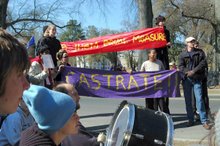




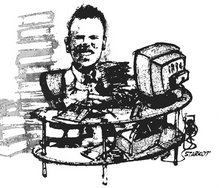
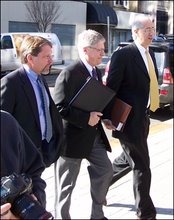
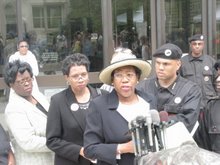
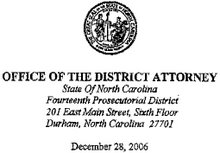
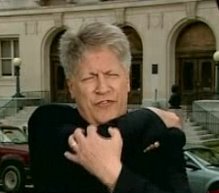

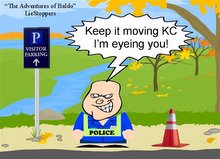

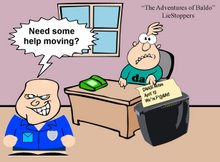

















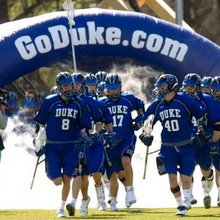

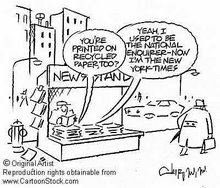


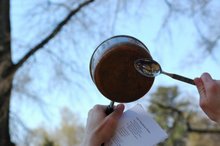

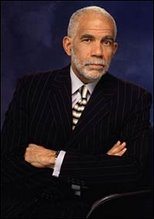
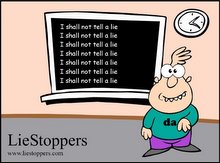






10 comments:
Very, very good work, Liestoppers!! We really are dealing with slime, from the "journalists" like Khanna at the N&O to Karla Holloway and the others in the Duke administration.
Is there no end to the lies that these people tell? It seems that Crystal, Nifong, and the police are not the only liars here.
Wow Momtothree!
Excellent post! You bring everything together in a compelling way. Thanks.
Carolyn says:
What hypocrisy! Khanna writing that Crystal's "ACCUSERS are white".
Hey! The players didn't accuse anybody - Crystal did. And Khanna became an accuser herself when she printed and supported Crystal's lying accusations. How dare Khanna smear the players with a name she deserves herself.
Talk about the pot calling the kettle black.
And, no, that is NOT a racial slur!
Carolyn says:
"Momtothree" - my sincere apologies for not saying this earlier.
Your detailed analysis amazes me. You have taken confusion and lies and unraveled them into clarity and truth. Thank you.
It is amazing how use of the "n" word by one player in response to a racial and sexual slur made by Kim Roberts has been exaggerated by the media, especially since none of the former defendants were involved. The Coleman Report specifically stated there was no evidence of racism on the LAX team, a fact confirmed by the teams only Africa-American player.
This is one of a long list of "red herrings" used against the LAX team.
Great post, Mom to Three! Thanks so much!
Terrific essai - Kin's "I just don't remember it that way" is stupid. The answer should be yes or no. SHe is to cute by half.
.
An exhaustive reporting of facts and little known circumstances that collectively had a huge impact on the case.
Very Impressive.
Tony Soprano
kim said the n word echoed on the 60 minutes infomercial. the last time i checked, echoed meant that something was repeated by more than one person so this one person said the n word is more apologising bs. when are you going to face the fact that the lax team behaved poorly that night and stop making yourselves look stupid in trying to make their unacceptable behavior acceptable?
Echoed? Are there any credible witnesses that there were any racial epithets that were not done in response to racial slurs uttered by one of the strippers? The Attorney General of the State of North Carolina didn't think so. His investigators never found any evidence to support that false allegation. Furthermore, would any amount of non-criminal "unacceptable behavior" warrant the kind of attacks on their character, presumption of guilt by a rogue prosecutor who only did so to get reelected, and the gross violations of civil rights and criminal law by the DPD and Durham DA's office? Tell me, you son of a bitch! If this were one of your friends or a family member who was facing 30 years for a crime that never occurred, would you be taking this disingenuous and specious stance, you hypocritical sack of (deleted)?!
Post a Comment